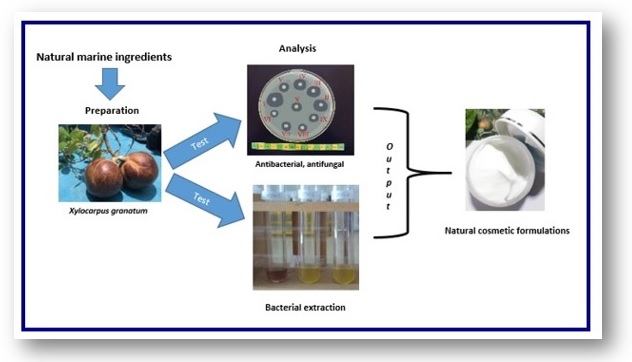Document Type : CASE STUDY
Authors
1 Department of Marine Science, Faculty of Fisheries and Marine Science, Diponegoro University, Jl. Prof. H. Soedarto, S.H., Tembalang, Semarang, Central Java, 50275, Indonesia
2 Faculty of Fisheries and Marine Sciences, Riau University, Pekanbaru, Indonesia
3 Research Center for Oceanography, National Research and Innovation Agency (BRIN), Ancol, Jakarta, Indonesia
Abstract
BACKGROUND AND OBJECTIVES: Mangroves are known to contain tannins, flavonoids, and quinones, which have the potential to be antibacterial, effective even against multidrug-resistant bacteria. Mangroves also have antifungal and antiviral properties. Although, mangroves are known for their use as medicinal ingredients, information regarding symbiont bacteria’s antibacterial and antifungal potential is still scarce. Therefore, this study aimed to examine symbiont bacteria in the fruit and leaves of Xylocarpus granatum as additional raw materials for anti-acne cosmetic creams and moisturisers.
METHODS: Symbiont bacteria were isolated using the pour plate method through Zobell 2216E and incubated for 2 x 24 hours at 27.5 Celcius degree. Afterwards, 13 isolates were successfully isolated and characterised based on their morphology. Further, everal tests were conducted, including the antibacterial test, antifungal test, molecular identification, and gas chromatography-mass spectrometry. The pathogenic bacteria used in the antibacterial test were Staphylococcus aureus, Vibrio harveyi, and Vibrio alginolyticus
FINDINGS: The antibacterial test results showed that eight isolates were capable of producing an inhibition zone against S. aureus, seven isolates were positive for antibacterial activity against Vibrio harveyi, and 10 isolates were positive for antibacterial activity against Vibrio alginolyticus. The pathogenic fungi used in the antifungal test were Malassezia furfur and Candida albicans. The antifungal test results demonstrated that six isolates could produce inhibition zones against Malassezia furfur and Candida albicans. Furthermore, molecular identification was carried out on six potential isolates based on the antibacterial and antifungal tests, which were X2.52, X1.65, X1.64, X1.53, X1.54, and X1.63. The molecular identification results revealed the occurrence of four species in the Xylocarpus granatum mangroves, namely, Sinomicrobium oceani, Proteus mirabilis, Pseudomonas khazarica, and Alcaligenes aquatilis.
CONCLUSION: The study found that the mangrove symbiont bacteria had antibacterial and antifungal potential. The compound with the highest concentration in six isolates was 9-octadecenoic acid, methyl ester. This type of content has antibacterial potential and is also predicted to have antifungal potential.
Graphical Abstract
Highlights
- A preliminary study conducted to obtain cosmetic ingredients from the sea and is expected to be without side effects because they consist of natural marine ingredients;
- The mangrove symbiont bacteria type granatum was found to have potential as an antibacterial and antifungal;
- Bacterial material found as a reference for obtaining cosmetic formulations, moisturizing tests, characterization of cosmetic preparations.
Keywords
Main Subjects
OPEN ACCESS
©2023 The author(s). This article is licensed under a Creative Commons Attribution 4.0 International License, which permits use, sharing, adaptation, distribution and reproduction in any medium or format, as long as you give appropriate credit to the original author(s) and the source, provide a link to the Creative Commons license, and indicate if changes were made. The images or other third-party material in this article are included in the article’s Creative Commons license, unless indicated otherwise in a credit line to the material. If material is not included in the article’s Creative Commons license and your intended use is not permitted by statutory regulation or exceeds the permitted use, you will need to obtain permission directly from the copyright holder. To view a copy of this license, visit:
http://creativecommons.org/licenses/by/4.0/
PUBLISHER NOTE
GJESM Publisher remains neutral concerning jurisdictional claims in published maps and institutional affiliations.
CITATION METRICS & CAPTURES
Google Scholar | Scopus | Web of Science | PlumX Metrics | Altmetrics | Mendeley |
CURRENT PUBLISHER
GJESM Publisher



Letters to Editor
[1] Letters that include statements of statistics, facts, research, or theories should include appropriate references, although more than three are discouraged.
[2] Letters that are personal attacks on an author rather than thoughtful criticism of the author’s ideas will not be considered for publication.
[3] Letters can be no more than 300 words in length.
[4] Letter writers should include a statement at the beginning of the letter stating that it is being submitted either for publication or not.
[5] Anonymous letters will not be considered.
[6] Letter writers must include their city and state of residence or work.
[7] Letters will be edited for clarity and length.
Send comment about this article